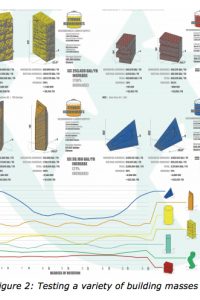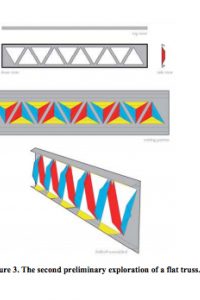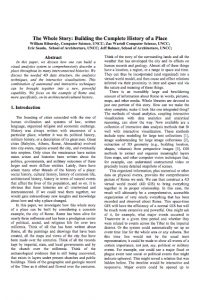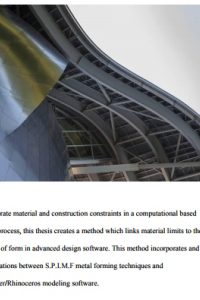Papers
“Quilting” – Material Ecology Through Responsive Design Processes
By designing the geometry of a form through its material constraints, we can minimize the amount of customized components while maximizing form-making possibilities and ease of construction. This paper will outline our research demonstrating how architects might expand these systemic processes to larger objects and systems using a combination of relatively simple geometric definitions along […]

[Kak-tos]: A tool for optimizing conceptual mass design and orientation for rain water harvesting facades
In this paper, we will examine the impacts and potential for Wind Drive Rain to be harvested on the facades of buildings, and will describe a plug-in tool for schematic design for Autodesk Revit, which can assist in the definition of optimal geometries and orientation for a building to harvest water in its particular location […]

Zero-Waste, Flat Pack Truss Work: An Investigation of Responsive Structuralism
“The design engineer, in his prioritizing of materialization, is the pilot figure of this cultural shift which we have termed ‘new structuralism.’”(Oxman, Oxman, 2010) “It [architecture] must become more primitive in terms of meeting the most fundamental human needs with an economy of expression and mediating man’s relationship with the world…and more sophisticated in the […]

Urban User Interface
The January 2011 Egyptian uprising in Tahrir Square was called a “Facebook revolution,” but its importance is not that it was solely digital, but rather that information and space were bound in an arena for social change. Some recent work analyzing the location of tweets within Cairo reveals a pattern that is directly tied to […]

The Whole Story: Building the Complete History of a Place
In this paper, we discuss how one can build a visual analytics system to comprehensively describe a place throughout its many interconnected histories. We discuss the needed 4D data structure, the analytics techniques, and the interactive visualizations. This combination of automated and interactive techniques can be brought together into a new, powerful capability. We focus […]

The Mere Exposure Effect in Architecture
Architectural Design has ignored the natural processes of social segregation, letting other factors dominate the occupational organization of the built environment, ultimately isolating communities and their members. By incorporating modern social behavioral analytics into design logics, social spaces can facilitate more productive engagements between occupants. The goal is to create a more diverse and sustainable […]

The case for a theory of interactive architecture
Historically, architecture’s cultural role has changed in sometimes radical ways. A theory of contemporary architecture must deal with the proliferation of information and communication technologies, seeking a transformed role for the physical setting in a digital age. This paper reviews perspectives from computational disciplines, proposes the outline of a theory of interactive architecture, and presents […]

Slip Mounted Single Point Deformed Structural Skins
By Paul Stockhoff- Presented at ACSA 2017

Rethinking Urban Space and Time through Tweets: An Analysis of Tweet Communication in Mobile Food Vending Practices
The recent rise of food vending in U.S. cities combines physical mobility in urban space with continuous online communication. In contrast to traditional forms of urban space that have predictable and planned spatial locations, mobile food vending generates temporary forms of urban social activity mediated by websites such as Twitter. Given the unique nature of […]

Pinned Incremental Metal Forming
Advanced design software allows designers to rapidly create huge numbers of design variations. However, these variations do not incorporate material and manufacturing limits, which are typically considered much later during the process of design documentation. By creating a method, which incorporates these limits during the design process, we avoid iterations that would be difficult, costly, […]